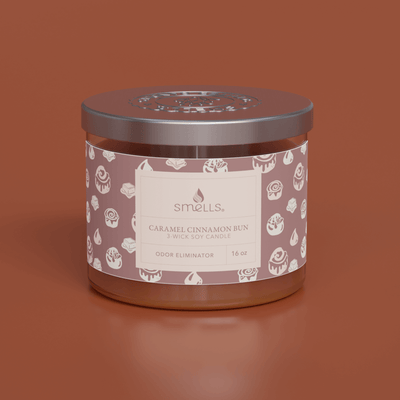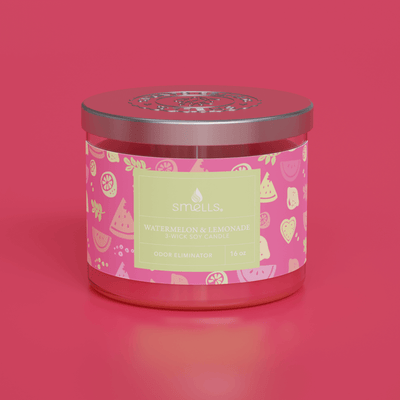Are scented candles toxic?

Table of Contents
Candles have been around for thousands of years – well before the invention of the lightbulb and the use of electricity as we know it these days. In ancient times, candles were our main source of light.
Even though this is not the case in today’s world, scented candles are still used in a number of ways, including decorations, in ceremonies, and to emanate aromas.
Nonetheless, there is an ongoing debate on the risks that burning candles may have on people’s health. People on one side of the argument claim that candles release harmful toxins, while those on the other side of the argument say that said toxins are not enough to pose a threat.
So, just how toxic are scented candles then? And should we be worried?
This article will present the scientific evidence that has been found so far in terms of the different elements of candles (wick, wax, organic compounds, smoke) and the effects these have on our health.
Do scented candles produce toxic chemicals?

Certainly, scented candles produce vapors that can be unsafe to inhale at high doses. Yet, research suggests that the dose people inhale from occasional candle-burning is well below what is considered harmful.
In 2014, a peer-reviewed study found that scented candles (most of which are made from a by-product of petroleum called paraffin) produce potential carcinogens such as benzene and formaldehyde.
However, the highest measured levels after four consecutive hours of burning in rooms of different sizes were less than half as high as the recommended indoor air-quality limits proposed by the World Health Organization. Also, the highest levels fell within the range of what is considered typical indoor air concentrations of the chemicals.
Are wicks made of lead?

In 2003, the U.S. Consumer Product Safety Commission (CPSC) banned the sale and production of candles with lead wicks as well as the import of lead-containing candles from other countries. In fact, most candle manufacturers stopped using lead in their candles as far back as in the 1970s due to concerns that fumes could cause lead poisoning.
Is wax made of toxic chemicals?
As previously mentioned, most modern candles are made from paraffin wax, and there are numerous alarming articles on the Internet about the dangers of cancer-causing chemicals scented-candles release into the air. A 2009 study found that burning paraffin wax releases potentially dangerous chemicals, such as toluene.
However, because the study was never published in a peer-reviewed journal the National Candle Association and European Candle Association questioned the study’s reliability, stating that “no data for review has been provided”, and “no reputable scientific study has ever shown any candle wax, including paraffin, to be harmful to human health.”
Therefore, the evidence that burning scented candle wax is damaging to human health is inconclusive.
Is candle smoke toxic?
It goes without saying that inhaling too much of any type of smoke can be hazardous to human health. Burning paraffin candles releases soot; therefore, to reduce the amount of smoke breathed in, it is advisable to light candles in a well-ventilated room, away from drafts that can increase the amount of smoke they release.
Do scented candles release particulate matter and volatile organic compounds?

Particulate matter consists of minute liquid droplets and particles that can make their way into people’s lungs. There’s concern that prolonged exposure to particulate matter can lead to heart and lung problems.
Volatile organic compounds (VOCs) are carbon compounds that, at room temperature, turn into a gas. While some VOCs naturally occur in flowers to produce a sweet aroma, other VOCs, such as formaldehyde and benzine, can potentially cause cancer.
People are regularly exposed to particulate matter and VOCs in their daily lives as they are found in car exhaust, factory pollution, and virtually anything that burns fossil fuels.
Burning candles releases volatile organic compounds and particulate matter into the air; however, a 2014 study examining the amount of particulate matter emitted from burning candles found that the amount released is not enough to cause health problems in humans.
Are there any candles made from a healthier source of wax?
Compared to the pollution people breathe in their everyday lives, the smoke from burning candles in a well-aired area is unlikely to have a major impact on their health.
To reduce how much particulate matter is inhaled, using candles made from natural sources (coconut wax, beeswax, soy wax, palm wax, vegetable wax) is the best option. According to one study, natural candles seem to release the lowest amount of potentially dangerous chemicals.
In conclusion, there isn’t any definitive research showing that exposure to candle smoke increases the risk of developing any specific health condition. At Smells, we recommend that, if you use candles regularly, you burn them in a well-ventilated room to minimize the amount of smoke you breathe in.
All our candles are made of premium, non-toxic, clean-burning and long-lasting and 100% soy wax. We would like you to try our 3-wick Coconut Milk & Mango candle, made from 100% cotton wicks to perform a clean and long burning candle.









Leave a comment